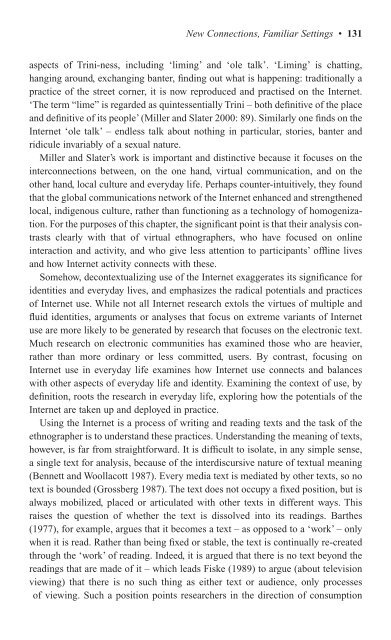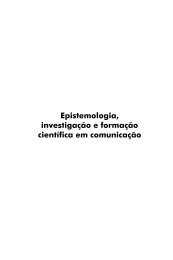Virtual Methods
Virtual Methods
Virtual Methods
Create successful ePaper yourself
Turn your PDF publications into a flip-book with our unique Google optimized e-Paper software.
New Connections, Familiar Settings • 131<br />
aspects of Trini-ness, including ‘liming’ and ‘ole talk’. ‘Liming’ is chatting,<br />
hanging around, exchanging banter, finding out what is happening: traditionally a<br />
practice of the street corner, it is now reproduced and practised on the Internet.<br />
‘The term “lime” is regarded as quintessentially Trini – both definitive of the place<br />
and definitive of its people’ (Miller and Slater 2000: 89). Similarly one finds on the<br />
Internet ‘ole talk’ – endless talk about nothing in particular, stories, banter and<br />
ridicule invariably of a sexual nature.<br />
Miller and Slater’s work is important and distinctive because it focuses on the<br />
interconnections between, on the one hand, virtual communication, and on the<br />
other hand, local culture and everyday life. Perhaps counter-intuitively, they found<br />
that the global communications network of the Internet enhanced and strengthened<br />
local, indigenous culture, rather than functioning as a technology of homogenization.<br />
For the purposes of this chapter, the significant point is that their analysis contrasts<br />
clearly with that of virtual ethnographers, who have focused on online<br />
interaction and activity, and who give less attention to participants’ offline lives<br />
and how Internet activity connects with these.<br />
Somehow, decontextualizing use of the Internet exaggerates its significance for<br />
identities and everyday lives, and emphasizes the radical potentials and practices<br />
of Internet use. While not all Internet research extols the virtues of multiple and<br />
fluid identities, arguments or analyses that focus on extreme variants of Internet<br />
use are more likely to be generated by research that focuses on the electronic text.<br />
Much research on electronic communities has examined those who are heavier,<br />
rather than more ordinary or less committed, users. By contrast, focusing on<br />
Internet use in everyday life examines how Internet use connects and balances<br />
with other aspects of everyday life and identity. Examining the context of use, by<br />
definition, roots the research in everyday life, exploring how the potentials of the<br />
Internet are taken up and deployed in practice.<br />
Using the Internet is a process of writing and reading texts and the task of the<br />
ethnographer is to understand these practices. Understanding the meaning of texts,<br />
however, is far from straightforward. It is difficult to isolate, in any simple sense,<br />
a single text for analysis, because of the interdiscursive nature of textual meaning<br />
(Bennett and Woollacott 1987). Every media text is mediated by other texts, so no<br />
text is bounded (Grossberg 1987). The text does not occupy a fixed position, but is<br />
always mobilized, placed or articulated with other texts in different ways. This<br />
raises the question of whether the text is dissolved into its readings. Barthes<br />
(1977), for example, argues that it becomes a text – as opposed to a ‘work’ – only<br />
when it is read. Rather than being fixed or stable, the text is continually re-created<br />
through the ‘work’ of reading. Indeed, it is argued that there is no text beyond the<br />
readings that are made of it – which leads Fiske (1989) to argue (about television<br />
viewing) that there is no such thing as either text or audience, only processes<br />
of viewing. Such a position points researchers in the direction of consumption



